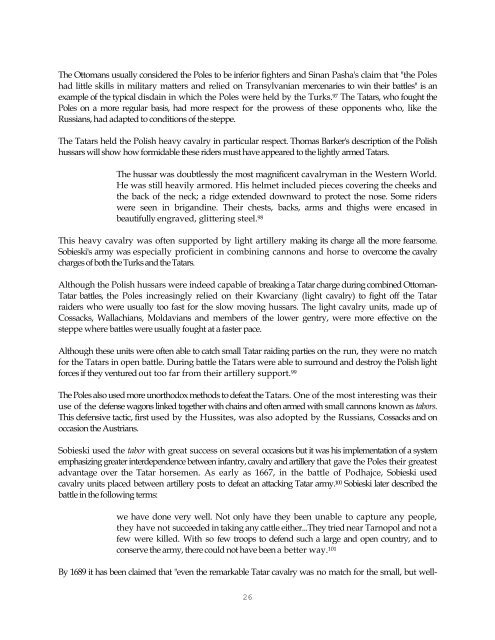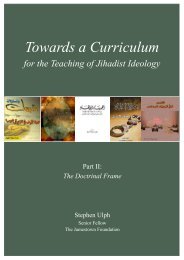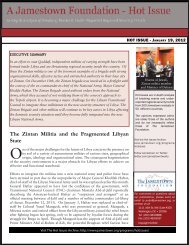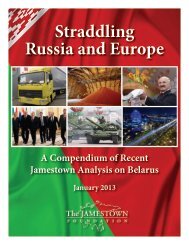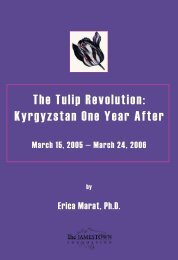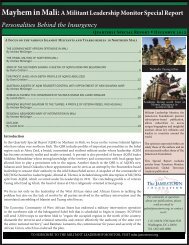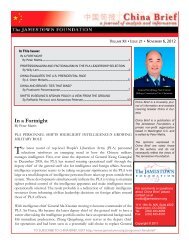By Brian Glyn Williams - The Jamestown Foundation
By Brian Glyn Williams - The Jamestown Foundation
By Brian Glyn Williams - The Jamestown Foundation
You also want an ePaper? Increase the reach of your titles
YUMPU automatically turns print PDFs into web optimized ePapers that Google loves.
<strong>The</strong> Ottomans usually considered the Poles to be inferior fighters and Sinan Pasha's claim that "the Poles<br />
had little skills in military matters and relied on Transylvanian mercenaries to win their battles" is an<br />
example of the typical disdain in which the Poles were held by the Turks. 97 <strong>The</strong> Tatars, who fought the<br />
Poles on a more regular basis, had more respect for the prowess of these opponents who, like the<br />
Russians, had adapted to conditions of the steppe.<br />
<strong>The</strong> Tatars held the Polish heavy cavalry in particular respect. Thomas Barker's description of the Polish<br />
hussars will show how formidable these riders must have appeared to the lightly armed Tatars.<br />
<strong>The</strong> hussar was doubtlessly the most magnificent cavalryman in the Western World.<br />
He was still heavily armored. His helmet included pieces covering the cheeks and<br />
the back of the neck; a ridge extended downward to protect the nose. Some riders<br />
were seen in brigandine. <strong>The</strong>ir chests, backs, arms and thighs were encased in<br />
beautifully engraved, glittering steel. 98<br />
This heavy cavalry was often supported by light artillery making its charge all the more fearsome.<br />
Sobieski's army was especially proficient in combining cannons and horse to overcome the cavalry<br />
charges of both the Turks and the Tatars.<br />
Although the Polish hussars were indeed capable of breaking a Tatar charge during combined Ottoman-<br />
Tatar battles, the Poles increasingly relied on their Kwarciany (light cavalry) to fight off the Tatar<br />
raiders who were usually too fast for the slow moving hussars. <strong>The</strong> light cavalry units, made up of<br />
Cossacks, Wallachians, Moldavians and members of the lower gentry, were more effective on the<br />
steppe where battles were usually fought at a faster pace.<br />
Although these units were often able to catch small Tatar raiding parties on the run, they were no match<br />
for the Tatars in open battle. During battle the Tatars were able to surround and destroy the Polish light<br />
forces if they ventured out too far from their artillery support. 99<br />
<strong>The</strong> Poles also used more unorthodox methods to defeat the Tatars. One of the most interesting was their<br />
use of the defense wagons linked together with chains and often armed with small cannons known as tabors.<br />
This defensive tactic, first used by the Hussites, was also adopted by the Russians, Cossacks and on<br />
occasion the Austrians.<br />
Sobieski used the tabor with great success on several occasions but it was his implementation of a system<br />
emphasizing greater interdependence between infantry, cavalry and artillery that gave the Poles their greatest<br />
advantage over the Tatar horsemen. As early as 1667, in the battle of Podhajce, Sobieski used<br />
cavalry units placed between artillery posts to defeat an attacking Tatar army. 100 Sobieski later described the<br />
battle in the following terms:<br />
we have done very well. Not only have they been unable to capture any people,<br />
they have not succeeded in taking any cattle either...<strong>The</strong>y tried near Tarnopol and not a<br />
few were killed. With so few troops to defend such a large and open country, and to<br />
conserve the army, there could not have been a better way. 101<br />
<strong>By</strong> 1689 it has been claimed that "even the remarkable Tatar cavalry was no match for the small, but well-<br />
26


